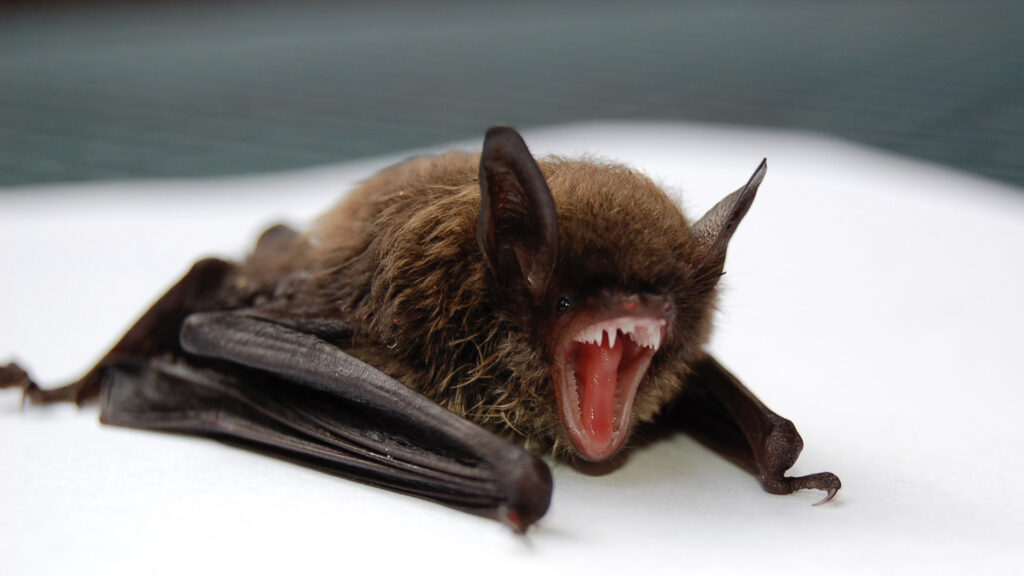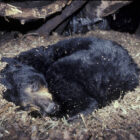Can a vampire bat kill a human?

Many myths and exaggerations have sprung up around the vampire bat, well beyond the nature of this peculiar flying mammal. But by distinguishing fantasy from reality, what remains true about the vampire bat?
In the world, there exist three species of bats that feed exclusively on blood: the common vampire bat (Desmodus rotundus), the hairy-legged vampire bat (Diphylla ecaudata), and the white-winged vampire bat (Diaemus youngi).
All three species live in Central and South America, in regions of Mexico, Brazil, Chile, Uruguay, and Argentina. Thus, we can dispel Indiana Jones: there are no blood-feeding bats in India.
Considering the differences among the three blood-feeding bats, each species has been placed in a specific genus and family. Despite the distinctive traits of each of the three species, the commonalities suggest that the blood-feeding behavior of these bats evolved in a single ‘evolutionary event’.
Vampire bats have characteristics that set them apart from common bats: thermal receptors somewhat similar to infrared sensors in snakes. Front teeth suited to pierce the skin; a specialized auditory system to determine the position of primary food sources from the sound of their victims’ regular breathing during sleep.
The hunting method of vampire bats
Contrary to most non-blood-feeding bats, vampire bats have noses equipped with specialized heat receptors, enabling them to locate the area where blood flows close to the skin of prey.
The vampire bats’ teeth have evolved to make small, precise incisions, while their hearing is capable of detecting the sound of a sleeping mammal’s regular breathing.
Vampires hunt only late at night, in complete darkness, feeding on the blood of both small and large mammals, including humans, or birds. To feed on mammals, they usually locate an immobile prey and land within a few meters, approaching by walking on the ground. Vampire bats are quite agile, capable of running at a maximum speed of nearly 8 km/h and moving adeptly on the body of a large mammal.
Surgical incision
Once near the prey, they begin their feast. Firstly, they locate the best spot for an incision using their thermal sensors. If the prey has fur, the common vampire bat uses its canines to shave the area where it will make a wound typically about 7 millimeters long and 8 millimeters deep.
As you might guess, without an ancient coagulation mechanism, the wound would close quickly. The vampire bat solves the blood’s fluidity issue by utilizing a series of anticoagulant, anesthetic, and vasodilatory agents present in its saliva.
One of these components is draculin, a protein that acts as an anticoagulant. It is approximately a hundred times more potent than any other known anticoagulant and is also used in medical contexts.
The vampires’ digestive system is highly efficient in digesting blood and is directly connected to the kidneys, causing the animal to urinate about 2 minutes after starting the meal.
This system of almost direct ingestion and expulsion of waste allows vampire bats to ingest an additional amount of blood equal to 20-30% of their body weight.
Can a vampire bat kill a human?
The size of a vampire bat varies from species to species. For example, typical size of a female common vampire bat is about 50 grams, approximately 9 centimeters in length with an 18-centimeter wingspan, and it can consume about half of its body weight in blood in just 20 minutes. The sizes of the other two species are not much different from those of the common vampire bat.
Again, cinematic depictions must be debunked: vampire bats cannot kill by causing severe bleeding. The blood loss for the victim is practically insignificant for a large mammal (around 25-30 milliliters), and the wounds are not severe enough to cause permanent damage.
The most common vampire bat species, Desmodus, is almost imperceptible to the prey during the attack and prefers large mammals. Diademus, on the other hand, seems to prefer birds and goats, and in the laboratory, it was impossible to force it to attack large mammals such as pigs or cows.
False vampires
So why does cinema present cases of enormous vampire bats killing humans as easily as a pterodactyl? This is an elaborate work of fiction concerning what are called ‘false vampires‘, defined as such because it was the cinema that attributed blood-sucking characteristics to some species, much larger than actual vampire bats.
This is the case, for example, of the Giant Golden-Crowned Flying Fox (Pteropus vampyrus), which, contrary to its scientific name, feeds exclusively on fruit. It reaches a wingspan of 1.8 meters and lacks echolocation.
It’s more likely that a vampire bat can kill a human by transmitting some blood diseases to which this predatory mammal is entirely immune. Cases of rabies transmission, although rare, are well-documented: in 2010, four children died of rabies after being bitten by a vampire bat.
The risk of rabies infection for the human population is lower than that for livestock: only 0.5% of vampire bats are carriers of the disease, and infected individuals are generally clumsy, disoriented, and unable to fly.
Innocent victims of the ‘vampire’ phenomenon
Vampire bats tend to live in colonies ranging from a few individuals to hundreds, located in almost entirely dark areas such as caves, tree hollows, or buildings.
Vampire bats have such strong social bonds that they are among the few species to ‘adopt’ the offspring of a dead or missing bat.
They are also closely tied to the colony through a food-sharing system: since a bat can survive about two days without a meal, during prey scarcity, bats that have fed regurgitate some of the ingested blood to share with the weaker members of the colony.
Vampire bats are also particularly adept at monitoring the position of other individuals of the same species, using distinctive calls to understand if a bat needs help.
Vampire bats are much less terrifying and lethal than depicted in movies. The only real risk for the victim is infections resulting from the bat, during its nightly hunting, coming into contact with different species of mammals or birds, contributing to the spread of infections and parasites.
Vampire bat
The Art and Science of Bats










